When it comes to making a meal, the easiest parts for me to plan are the protein and the starch. The challenge for me is deciding how to include an appropriate amount of veggies. Sauteing vegetables is a simple, quick solution to incorporate vegetables into your dish that are oh-so flavorful!
This post is part of our Basic Cooking Skills series. Each week we will be doing a deep-dive into one basic cooking skill and a brand new recipe to accompany it to practice that newfound skill. Check back throughout the series for updates and new posts.
What does sauteing mean?
Sauteing is a cooking process in which food is fried in a small amount of fat. Heat a skillet or pan over medium-high heat with a splash of olive oil or butter to coat the bottom. Voila! You’re ready to get started.
This method of heating is conduction (which we learned more about in our elements of cooking post here). Fat aids this process by browning the food
Vegetables are ideal candidates for sauteing as it works best for food that cooks for a short amount of time. The amount of time it takes to saute vegetables varies, but generally about 15 minutes.
What I think is really cool is that the vegetables maintain their nutritional benefits. Whereas boiling or roasting veggies can take upwards of an hour, and boiling can cause the vegetables to lose a good portion of their nutrients.
Sauteing vegetables definitely has its perks: it’s quick, delicious, and has nutritional benefits. But can all vegetables be sauteed?? Keep reading!
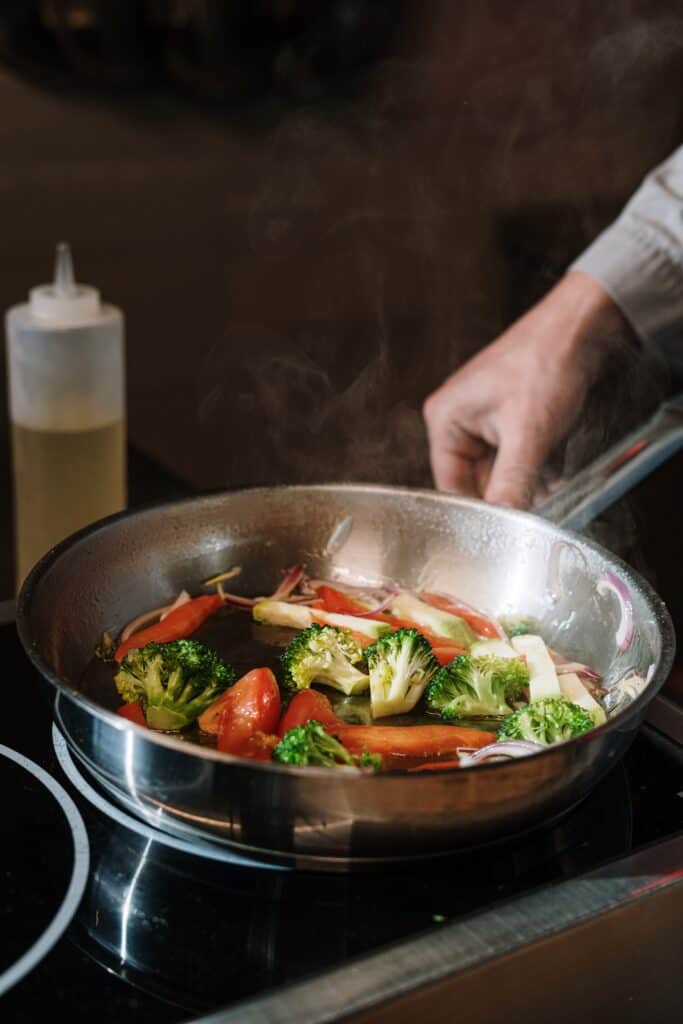
materials needed for sauteing vegetables
Best vegetables to Saute?
I have good news for you….practically any vegetables will do!
One of my favorite things about sauteeing is the diverse amount of veggies you can use! I can’t think of one vegetable that can’t be sauteed.
Leaner vegetables are the most suitable for sauteing in short amounts of time. But by slightly adjusting the amount of cook time, there isn’t a veggie out there that can’t be made delicious tossed in a little bit of fat in a hot pan.
best fat to saute vegetables?
Olive oil and butter are the classic fats to use when it comes to sauteeing. Both have pros and cons depending on your individual goals.
Butter can add loads of delicious flavor and may be best if you’re trying a vegetable you’re not very fond of. When I first started eating brussels I preferred cooking them with butter, but now I enjoy them with oils of less intense flavor, such as olive oil.
Olive oil is pretty much the standard for cooks across the world. It’s very all-purpose, inexpensive, and hard to mess up. Olive oil provides complementary flavor without overpowering what you’re cooking. It is also much healthier than butter and is a good source of good fat to add into your diet.
One downside to using butter and olive oil is that they have fairly low smoke points. When using very high heat they may start to smoke and affect the flavor of the vegetables. Oils with high smoke points can be used for very high heat, such as avocado oil or grapeseed oil.
best pan to saute vegetables?
When it comes to sauteing, most pans will work just fine. There are, however, a few qualities that help make this cooking process even easier for you.
An ideal pan to saute vegetables has a wide base, straight sides, and distributes heat evenly.
A wide base and straight sides increase the surface area of the pan. More surface area = more room for veggies!
It’s very common for skillets to have slanted sides, and those will work too. Take note that you may not be able to fill it with quite as many vegetables as you would with a straight-sided pan, but that can easily be adjusted and you can do a few rounds instead.
The distribution of heat evenly is essential to simplify the cooking process. A pan with a heavy bottom works best and will cook similar vegetables at similar speeds. If your pan is thin or warped, part of the pan make cook much slower than others and make it difficult to know when each individual vegetable is fully cooked.
tips for perfectly sauteing vegetables
- This technique works best when the vegetables are chopped into bite-size pieces and are about the same size.
- Sauteing is a dry heat cooking method, so the vegetables should be as dry as possible. The wetter the veggies, the less intense flavor and less crispiness you’ll end up with.
- When heating the pan, you can test how hot it is by a drop of water in the pan. If it sizzles, the pan is hot enough to saute!
- Only a little bit of fat should be added to the pan. You can always add more if you need to, and pour out an excess if too much.
- Start with the more dense vegetables that take longer to cook. Then after a few minutes of cooking begin adding in other vegetables that require less time.
- Try to avoid overcrowding the pan. If the vegetables don’t have enough room in the pan they’ll start steaming each other, which keeps them from crisping up and cooking properly.
- The key to a good saute is not stirring too much. You definitely want to toss the veggies to make sure all sides are cooked but allow the vegetables to rest for a few minutes between stirs.

how to season and serve sauteed vegetables
Vegetables can be sprinkled with seasoning, tossed (but not lost😉 ) in the sauce, and served as a fantastic dinner side!
- Italian: add dried basil, oregano, Parmesan cheese; toss in pesto, tomato sauce, or cheese sauce
- Japanese: add ginger, sesames, black pepper; toss in teriyaki sauce
- Mexican: add cumin, cayenne pepper, oregano; toss in an enchilada sauce or serve on tortillas
- Indian: add coriander, turmeric, or curry powder; toss in a curry sauce
Pin me!
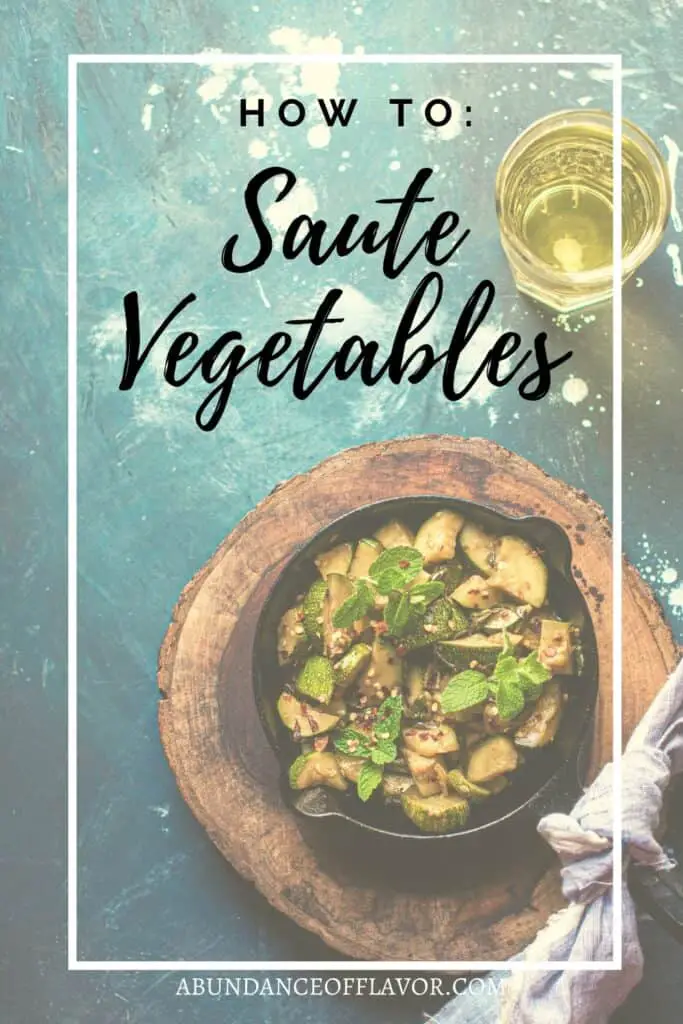
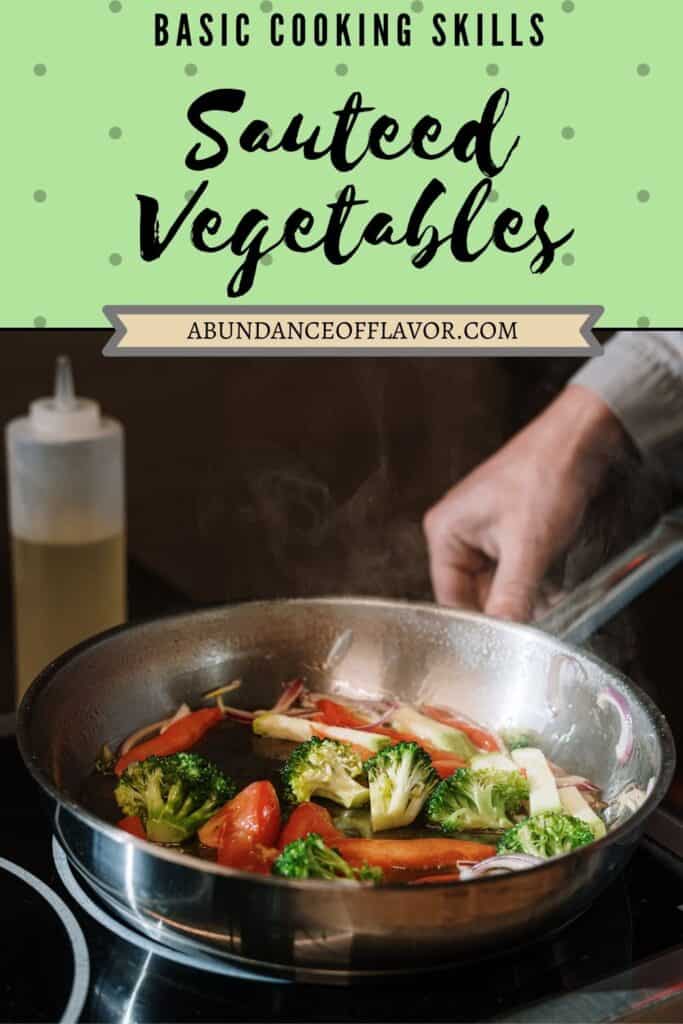
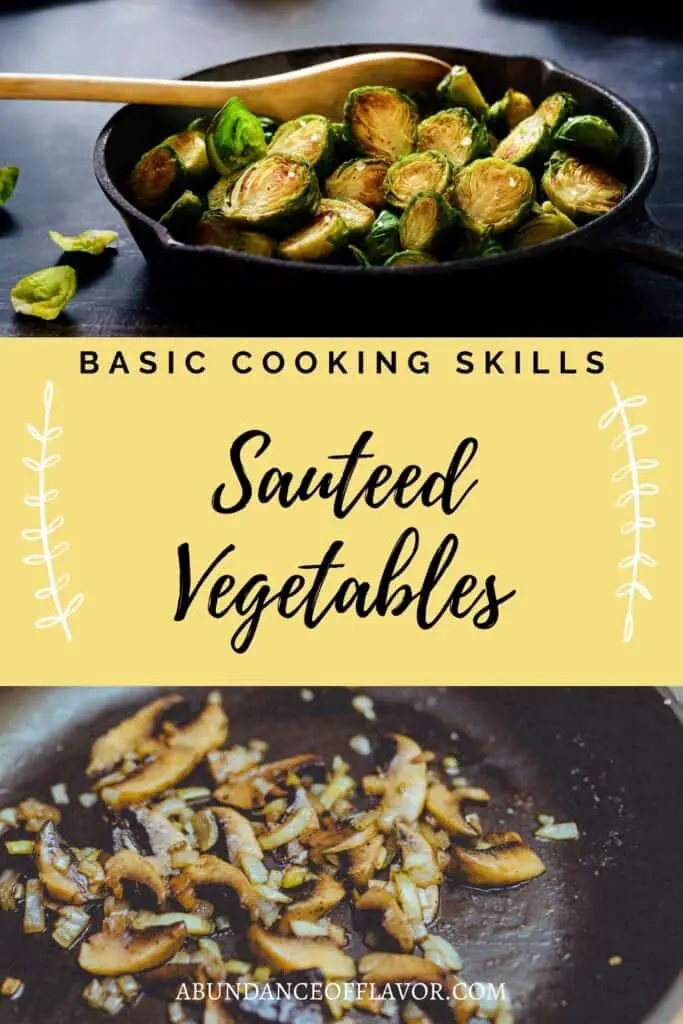
implement your new skill
Now I hope you’ve learned something new about perfectly sauteing vegetables! This Thursday I’ll be sharing a really tasty side dish recipe that will let you put your sauteing skills to test. Be on the lookout!
****UPDATE: Check out Mexican Sauteed Veggies available now!
What are you favorite combinations of veggies to saute? Mine has to be zucchini, mushrooms, and onions (tossed in a little soy sauce…YUM). Share in the comments below!


Related Posts
·

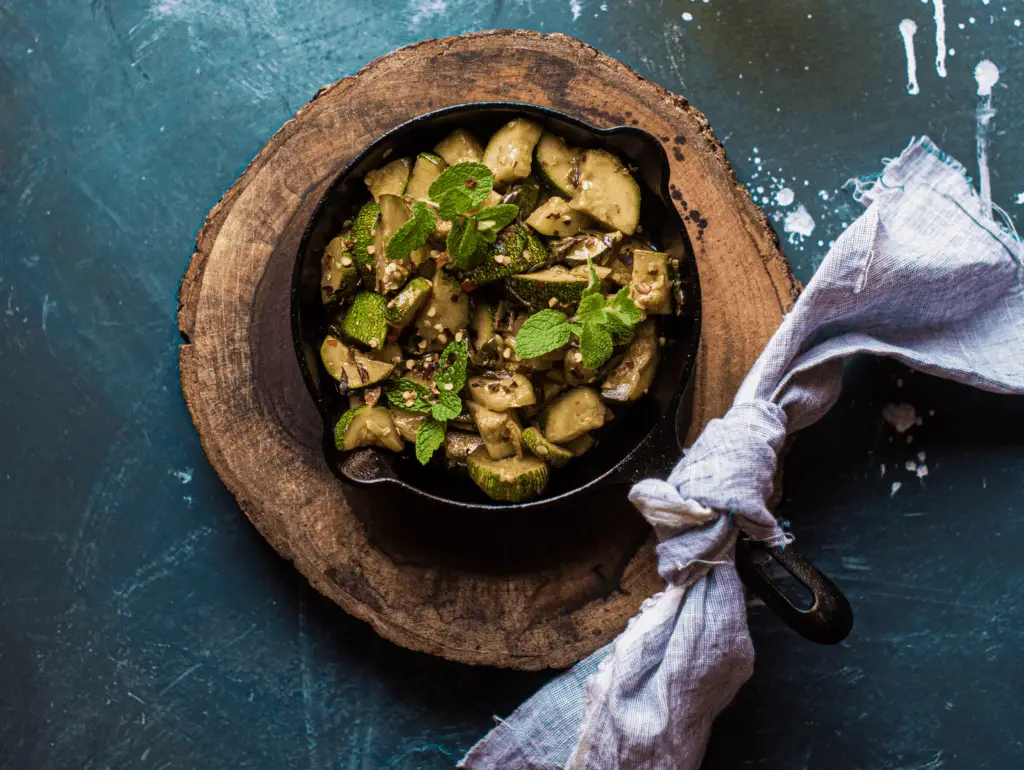
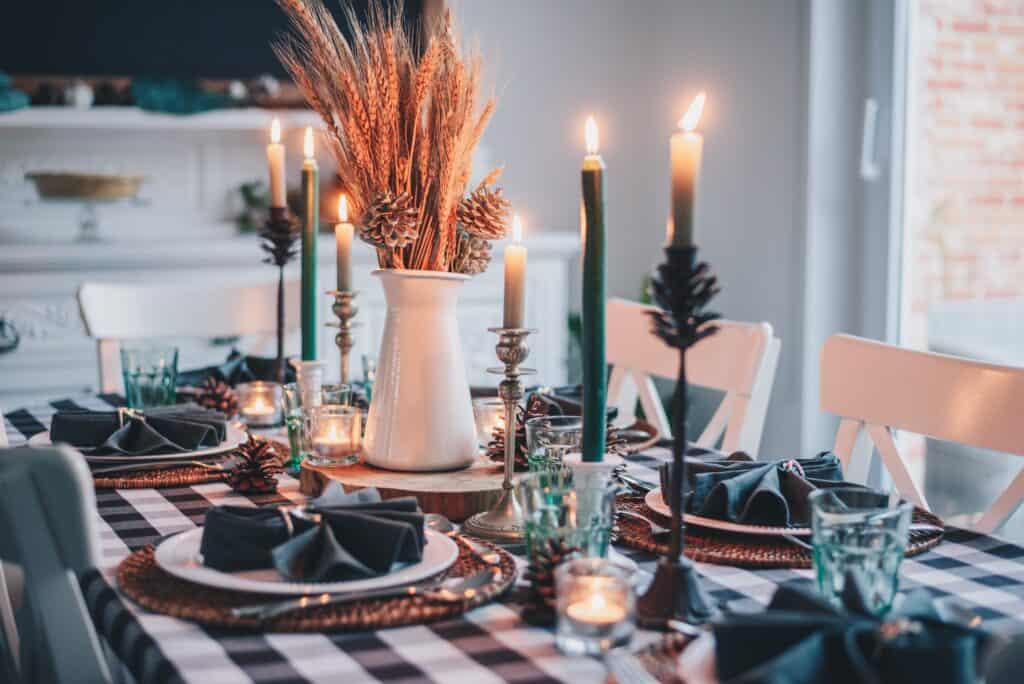
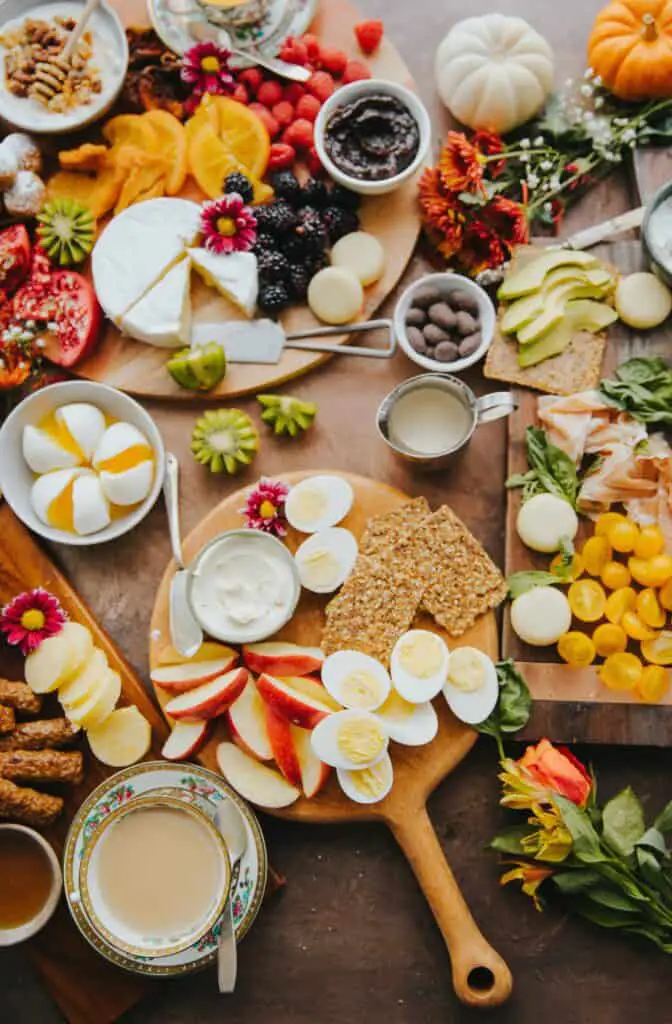

Thanks for inspiration. The toughest part for me
is to know which vegetables to combinate so
I like to use recipes..
It really takes a lot of trial and error! I’ve messed up a million times and finally found something I could rely on haha
Thank you so much for sharing this! I did not know about smoke points or that there are best pans to use! Thanks!
I’m glad you learned something new! 🙂
Great post! I didn’t know about this before so thank you for sharing this!
I’m so glad to hear! Thanks for commenting!
I like the short cooked veggies very much. I prefer to add soya sauce, herbs and sea salt.
Yummm, I love tossing sauteed veggies in soy sauce!
I am obsessed with sauteed vegetables. But I think a lot of people don’t eat vegetables because they think they won’t like the taste or they are worried about cooking them. You really broke it down and made it easy to understand how to saute vegetables for a delicious meal. Nice post!
That was 100% once me! I used to not eat any vegetables until I learned how to properly cook them. Now I want a side of sauteed veggies at every dinner 🙂
Mm I love sautéed veggies and potatoes! This is a very helpful post, there are some tips I didn’t even know about like not stirring too much! I love veggies – they are so underrated and yet such a versatile ingredient. Guess what I am having for dinner!
Em x
http://www.loveemblog.com
Thanks so much for your comment! I’m so glad this was helpful!
I love these tips! Sautéing vegetables is sooo yummy!
They’re so easy and are my fave at dinnertime!
This has been so helpful! I normally just boil the life out my veggies so no wonder they’re bland and mushy 🤣 Whenever I’ve tried sautéing veg before it’s not been great but I think that’s because I use too much oil! Thanks for the tips!
Sometimes it just takes a little bit of trial and error to find out the right amounts to use! I used to be super picky but now there’s not a veggie I won’t eat that’s sauteed in butter 🙂
Ah! This is great!! We love vegetables! Thanks so much for the tips!
Thanks so much! I used to not like ANY veggies but now I crave them all the time!
I love having these when I’m in a restaurant but I didn’t realise it was so easy to do at home. Thank you for sharing these great tips.
At first I was intimidated by it but it’s really so simple and quick to do at home! I love customizing them with fun spices and flavors too
I love sautéing vegetables, it’s funny I just ate sautéed veggies this evening but the oil I used was a bit much. Thanks for this post, I have learnt from it
Perfect timing! It’s really easy to overdo the oil and that’s one thing I tend to struggle with. Thanks for commenting 🙂
I know I’m guilty of overcrowding (there are 6 of us, after all), but I think I’m guilty of overstuffing, too.
I’ve been upgrading my pans, and it makes cooking much easier now that they are even and heavier.
It’s amazing what difference a good quality pan makes!
Wow, even though I kind of got good at sauteing these days. I learned a lot of things from this post. Thank you so much 💖
That’s so good to hear, I’m glad it was helpful!
This is such an informative post! Thanks for sharing how to sauté 🙂
Thanks so much, I’m glad it was helpful!
I sauté veggies all the time but still learned some new things from this post, thanks for sharing!
I love to hear it 🙂 Thanks for your feedback!
This is such a mouthwateringly great post – absolutely one of the best ways to cook and enjoy vegetables! I know what I’m doing for dinner tonight! Thanks for sharing!
I love how it’s so delicious and sooo simple too! Thanks for commenting 🙂
I’m the world’s worst home cook. Thanks to your tips I’m going to be trying some sauteed garlic veggies tomorrow night (wish me luck!)
Can’t wait to hear how they turn out😉 Already sounds delicous!
Awesome post! I am a very basic cook and this is helpful to me. How long it takes to sautés Brussel sprouts? I might try that today for lunch 🙂
Yum, brussels are some of my favorites. They’re very hearty so most likely around 10-12 minutes
Great post! I could (should) eat sautéed vegetables everyday.
I used to not eat any veggies and now I can’t get enough of them 🙂 Thanks for commenting!
Very informative. Getting the vegetables dry is something I never knew before. Typically I would wash and cut and a lot of moisture would end up in the pan. I never thought it would hurt. Thanks for the tips.
It’s such an easy step for me to skip when I’m pressed for time but it really makes a huge difference! Thanks for commenting
Great tips, I love sautéed vegetables, thanks for sharing!
Thanks so much for your feedback!
Thanks for the great tips! Two things I had to learn over the years were not to stir too much or add too much fat. This style of veggie prep lends itself to so many delicious dishes!
It really does! I’m still trying to let the veggies sit and not stir too much. It’s hard to be patient when it’s cooking and smelling so good 🙂
I made sauteed courgettes for dinner tonight. Decide to throw in salt, pepper and a dash of lemon juice. Accidentally poured in much more lemon than expected. My family refused to eat it so I had the whole citrusy courgette to myself.
That sounds like it’d still be tasty to me! I love using lemon juice as a touch of acid in some dishes
I love to saute vegetables! Thank you for all of the tips and extra info in here. Great seasoning options!
Pingback: Roasting Meat - Abundance of Flavor
Pingback: Sauteing Meat, Poultry, & Seafood - Basic Cooking Skills - Abundance of Flavor
Pingback: Mexican Sauteed Vegetables - Abundance of Flavor
Pingback: Roasting Vegetables - Basic Cooking Skills - Abundance of Flavor
Pingback: 21 Basic Cooking Skills for Beginners - Abundance of Flavor